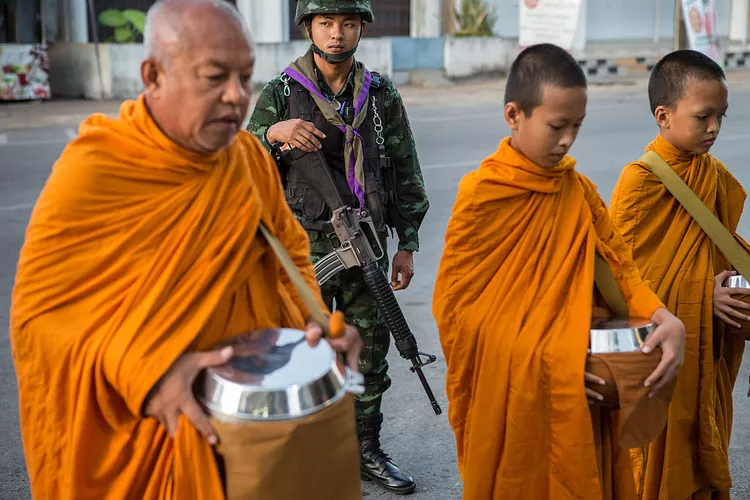Visiting These Risky Hotspots? Take Extra Care… or Don’t Go at All
Some little-explored spots in Southeast Asia are best left undiscovered. Simmering rebellions, ethnic clashes, and unresolved border issues in certain areas of the region simply do not allow for safe travel. These regions are thankfully limited, yet remain crucial to acknowledge: if you disregard State Department Warnings against travel to these areas, voiding your travel insurance may become the least of your concerns.
Caught in Crossfire: Kachin & Rakhine States, Myanmar
:max_bytes(150000):strip_icc():format(webp)/myanmar_rohingya-56a40d405f9b58b7d0d5287e.jpg)
Tourists visiting Myanmar should exercise extreme caution to avoid entering the country’s hotspots. The nation continues to face issues including firefights between government troops and ethnic rebels in the Kachin and northern Shan states, alongside an ongoing Buddhist vs. Muslim ethnic conflict in Rakhine State.
Wandering into unsafe territories can result in dire consequences. For instance, in April 2016, two German tourists were injured after triggering a mine while traversing a part of Shan State that experienced intermittent clashes between government and separatist forces.
The British Government advises against casual tourist activity in Rakhine State (excluding the well-known Ngapali Beach), Kachin State, and the Kokang region in Shan State.
The U.S. Department of State emphasizes the critical need for travelers in Myanmar to “maintain a high level of security awareness… avoid crowded public places, such as large public gatherings, demonstrations, and any areas cordoned off by security forces.”
Cultural Backlash: Southern Thailand
:max_bytes(150000):strip_icc():format(webp)/southern_thailand-56a40d403df78cf772809496.jpg)
The southern provinces of Yala, Narathiwat, and Pattani have been under Martial Law since 2005 due to a persistent rebellion that has escalated in violence over the past 15 years.
Historically Muslim, these provinces were once part of the Patani Sultanate which nominally paid tribute to the Siamese Kings. A drastic redrawing of borders and poor government attempts to erase the local culture have intensified a conflict that left approximately 6,000 people dead in Southern Thailand between 2004 and 2014.
Visitors to this part of Thailand should remain vigilant; car bombs have recently targeted the cities of Hat Yai and Songkhla, both crucial tourist transport hubs. The U.S. Department of State prohibits its personnel from traveling to these provinces and advises tourists to “defer non-emergency travel to these areas.”
Tense Relations: Indonesian Papua and Central Sulawesi
:max_bytes(150000):strip_icc():format(webp)/papua_men-56a40d405f9b58b7d0d52881.jpg)
Travelers are generally advised against casual travel to Central Sulawesi, Maluku, Papua, and West Papua provinces, where longstanding divisions have erupted into violence.
In Central Sulawesi and Maluku, tensions between the island’s Muslim and Christian communities have led to significant bloodshed, while an independence movement in Papua remains a continuous source of unrest.
Traveling to Papua isn’t outright banned; however, travelers must secure a surat jalan (travel permit) to enter Papua and West Papua. It’s important to bring passport-sized photographs and some local currency for the permit fees.
Knock-On Effects: Philippines Moro Regions in Mindanao
:max_bytes(150000):strip_icc():format(webp)/masjid_bacolod-56a40d415f9b58b7d0d52884.jpg)
Insurgent armies have been fighting for independence on the island of Mindanao since the 1960s, and rampant warlordism has exacerbated the situation. Political families, bolstered by the central government, have created personal militias ostensibly to combat rebels, intensifying local chaos.
The unrest largely affects the autonomous region in the far west, creating negative repercussions for tourism in Davao City and Cagayan de Oro City, both situated north and southeast of Mindanao, respectively. Nevertheless, both cities remain safe for tourists.
Step Lightly: Minefields in Cambodia and Laos
:max_bytes(150000):strip_icc():format(webp)/cmac_minefield-56a40d413df78cf77280949c.jpg)
The Vietnam War and the subsequent civil war have rendered Cambodia one of the world’s most heavily-mined countries. The Cambodian Mine Action Center (CMAC) estimates that approximately 6 million unexploded mines remain buried in the country, not accounting for the countless unexploded bombs resultant from U.S. military operations in Indochina.
While the Angkor National Park is safe for visitors, areas further off the beaten path may harbor dangerous surprises. Notably, the isolated temple of Banteay Chhmar has only recently been cleared of its mines. Hiring a local guide can ensure safety as they can provide crucial information on safe routes.




